For job seekers
For companies
For job seekers
For companies
Updated May 25, 2023 by Axel Grubba
Ready to find a remote job? Or expand your remote business?
Browse jobsFollowing the events of the 2020 COVID-19 pandemic, having left businesses and workers practically with no choice other than to take their work or their operations outside of physical offices, the conversations and the attitudes around remote work have definitely shifted.
However, two things remained unchanged – before, during, and after the pandemic.
First, remote workers love the perks of telecommuting, so much so that according to Buffer’s most recent State of Remote Work Report, many businesses are eyeing permanently allowing remote work, a significant increase from previous years. At the same time, those who switched from onsite work to remote work because of the pandemic say that they are now more excited about their jobs.
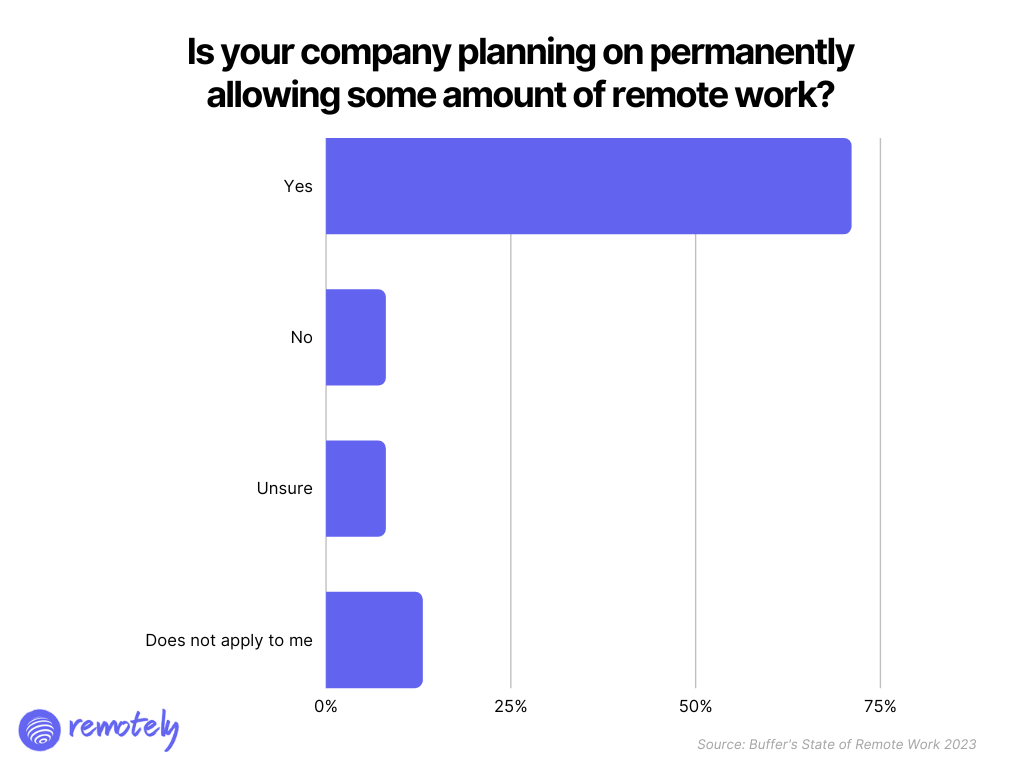 Most who switched to telecommuting since the global pandemic hit are more engaged with their jobs (Image source).
Most who switched to telecommuting since the global pandemic hit are more engaged with their jobs (Image source).
Second, while managing a remote team isn’t rocket science, it’s not a walk in the park either. According to a Society for Human Resources Management survey, among the organizations that were “forced” to transition to remote work, 70% found it difficult to adjust. This difficulty is more apparent in the professional/scientific/technical services, healthcare, and manufacturing industries.
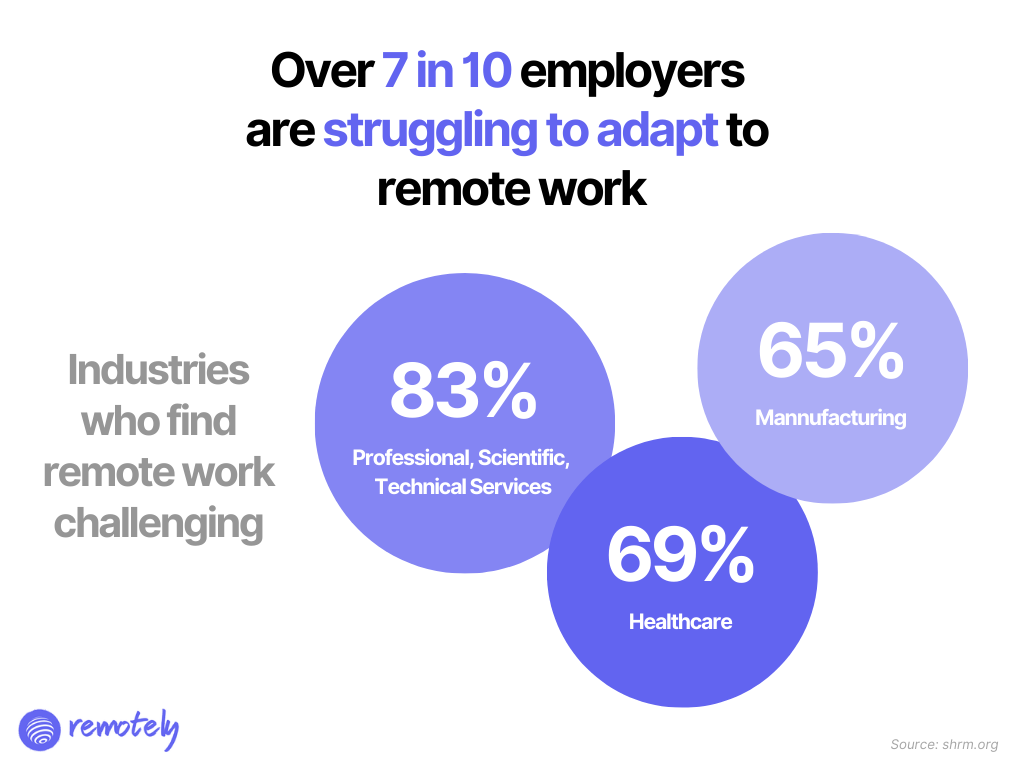 While the benefits of remote work are well-documented, several employers didn’t find it as easy to transition to telecommuting (Image source).
While the benefits of remote work are well-documented, several employers didn’t find it as easy to transition to telecommuting (Image source).
Some business leaders may argue that not being in the same physical space magnifies the managerial challenges of on-premise teams. There may be some truth to this, but it doesn’t mean that remote employees perform subpar versus onsite workers.
Everything considered, the net benefits of remote teams still outweigh the challenges including improved productivity, higher efficiency, stronger employee morale, increased employee loyalty and retention, and a wider hiring pool, just to name a few.
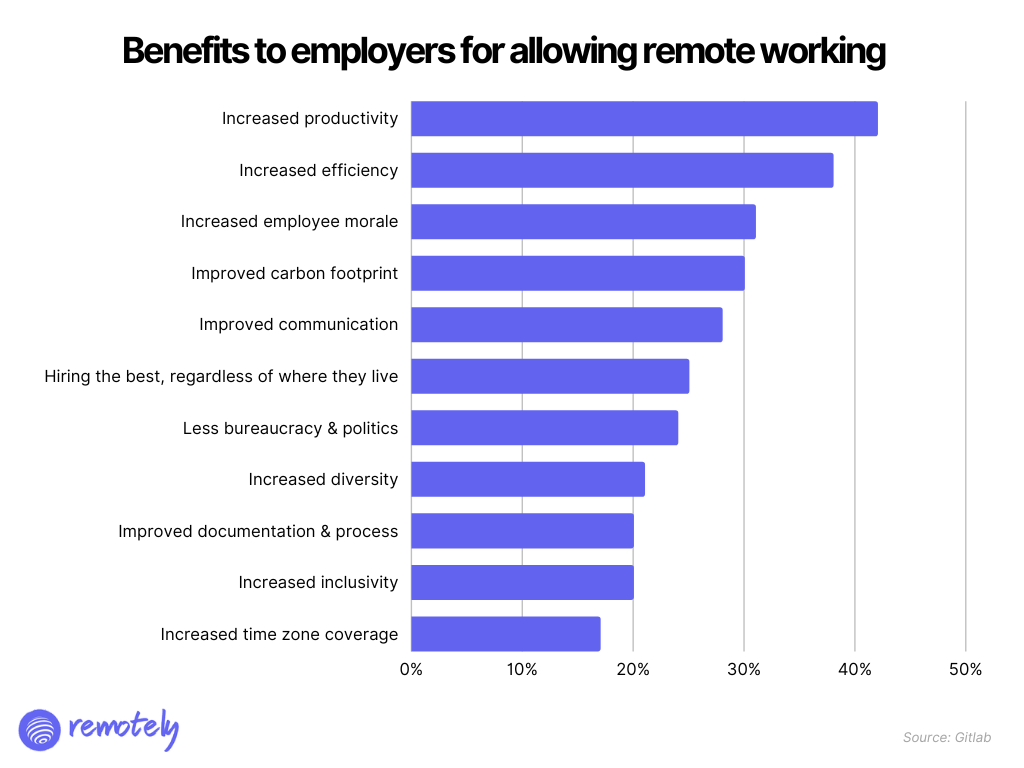 The well-researched advantages of remote teams outweigh the managerial challenges (Image source).
The well-researched advantages of remote teams outweigh the managerial challenges (Image source).
The good news is, there are real-world, proven, and well-documented strategies that successful remote companies have created, polished, and iterated that can serve as frameworks for other remote teams.
First, let’s do a quick review of the basics.
Used interchangeably with a number of terms – telecommuting, distributed work, work from home, work from anywhere, telework, distance work, and mobile work among others – remote work is a type of flexible work arrangement that gives employees the option to work outside the premises of a traditional physical office.
Taking off from this, a remote team a.k.a virtual team is a group of individuals who telecommute from various cities, regions/states, countries, and even continents, sometimes spanning different time zones, cultures, and languages.
Remote teams can be structured in several ways – remote work option, temporarily remote, hybrid, remote-first, and fully remote.
Each level of remote working would have its own set of challenges. However, there are common challenges that remote team managers need to deal with regardless of size, setup, and structure.
Communication – the “Big C” continues to plague many remote teams – from the most juvenile organizations to the most established businesses.
All editions of Buffer’s State of Remote Work rank communication as one of the top difficulties remote employees and remote team managers need to address. In a separate SHRM survey, more than 33% of newly inducted remote teams encountered communication problems. In another Hubstaff study, more than 45% of all managers surveyed cited lack of communication or miscommunication as the #1 problem they face when managing remote work.
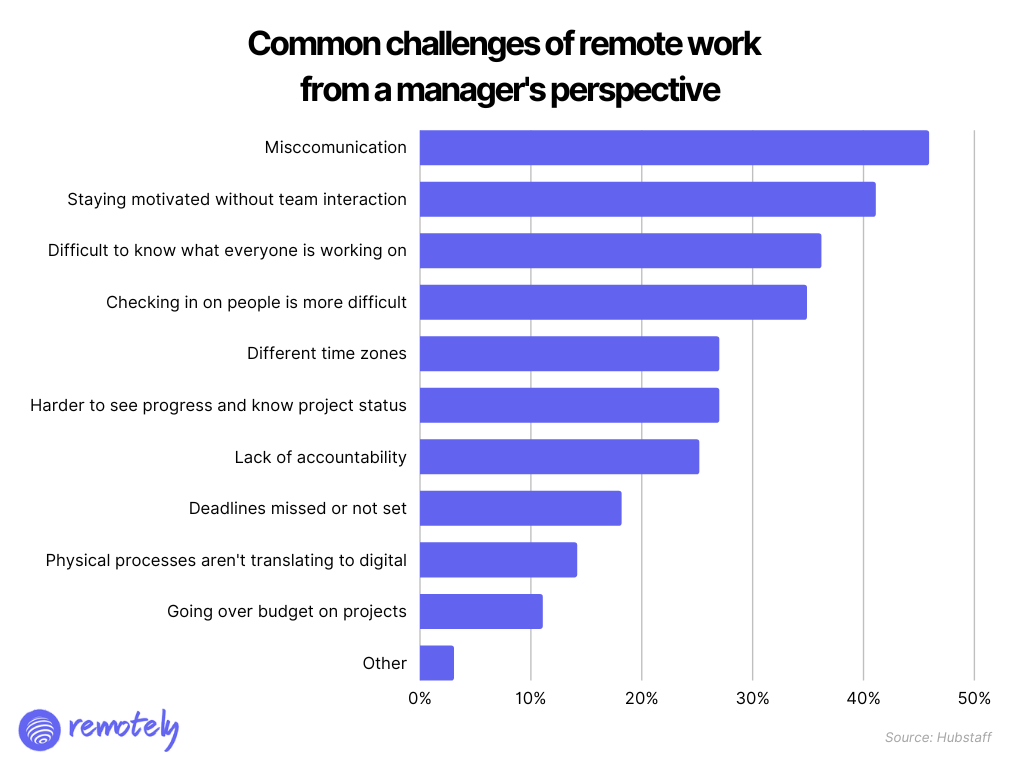 Newly transitioned remote teams have a problem with adjusting their communication tactics (Image source).
Newly transitioned remote teams have a problem with adjusting their communication tactics (Image source).
Arguably, it can be stipulated that effective communication is the cornerstone of successful telecommuting. A breakdown in this department opens a Pandora’s Box of other remote team issues.
The absence of physical, face-to-face interaction makes sufficient and strategic communication tools prerequisites for remote team success. The key is to have the right number of communication tools, a well-defined use case for each, and a balance of synchronous and asynchronous communication platforms.
Fully remote company Doist follows a pyramid of communication tools that outlines what communications tools to use when to use them, and for what purpose.
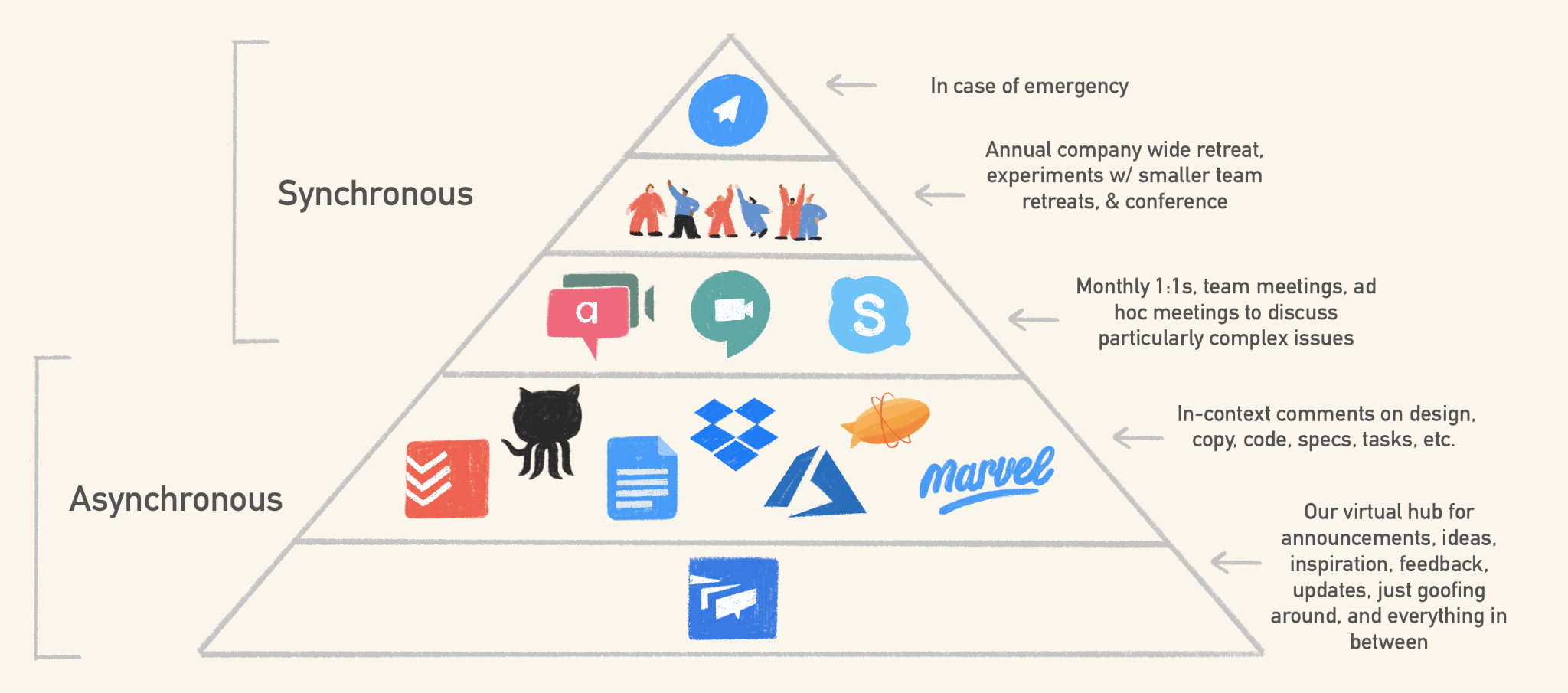 To keep communication free flowing and productivity at a high level, remote teams need a sufficient number of communication tools and a balance of both synchronous and asynchronous platforms (Image source).
To keep communication free flowing and productivity at a high level, remote teams need a sufficient number of communication tools and a balance of both synchronous and asynchronous platforms (Image source).
A close cousin of communication is collaboration. A breakdown in communication will almost always lead to a failure in collaboration.
However, other factors can lead to cracks in collaboration among virtual teams. These include the following:
Collaboration is an important hurdle that businesses need to overcome. So much so that at the height of the pandemic in 2020, 57% of businesses spent more on collaboration tools to make the “new normal” work for them.
 Remote teams are investing more in collaboration tools (Image source).
Remote teams are investing more in collaboration tools (Image source).
Campbell Soup Company former president and CEO Denise Morrison once said: “The single most important ingredient in the recipe for success is transparency because transparency builds trust.”
Remote work gives organizations flexibility and the freedom to work the way that suits them best. However, this can be a double-edged sword, leading to a lack of transparency. This could result in missed tasks or deadlines, stunted workflows, and low employee engagement and morale.
The most recent Hubstaff Tasks’ State of Remote Project Management Report outlines the following key findings related to transparency:
A lack of transparency in a remote team affects everyone across all levels in the organization. For owners, lack of transparency leads to fear that business growth will begin to stagnate. For managers, it’s the difficulty in monitoring and measuring work productivity, output, and engagement. This leads to anxiety that goals and KPIs are not being met. For employees, the absence of transparency results in fear that their supervisors think they’re slacking off – even if they’re working more hours than before.
One of the benefits of having a virtual team is the ability to hire remote workers from all over the world. With workers hailing from different social, historical, and geo-political backgrounds, it’s inevitable that cultural differences will arise.
There are advantages to this – diversity of ideas, higher creativity, and better problem-solving tactics.
However, it also has its downsides. According to Harvard Business Review, cultural differences, when not managed appropriately, may negatively affect “team climate.” Based on their research, when team members come from varying cultures, they find it less enjoyable working with each other, they trust each other less, they make non-favorable assumptions about each other, and they generally communicate less. This could lead to less cohesion and more misunderstandings and conflicts.
Not working in the same physical space is bound to result in some logistical issues.
Prior to the pandemic and back when remote work was just a buzzword among startups and the more “progressive” companies, certain logistical challenges have already come up such as distractions at home, being in different timezones, and having a reliable internet connection and computer equipment.
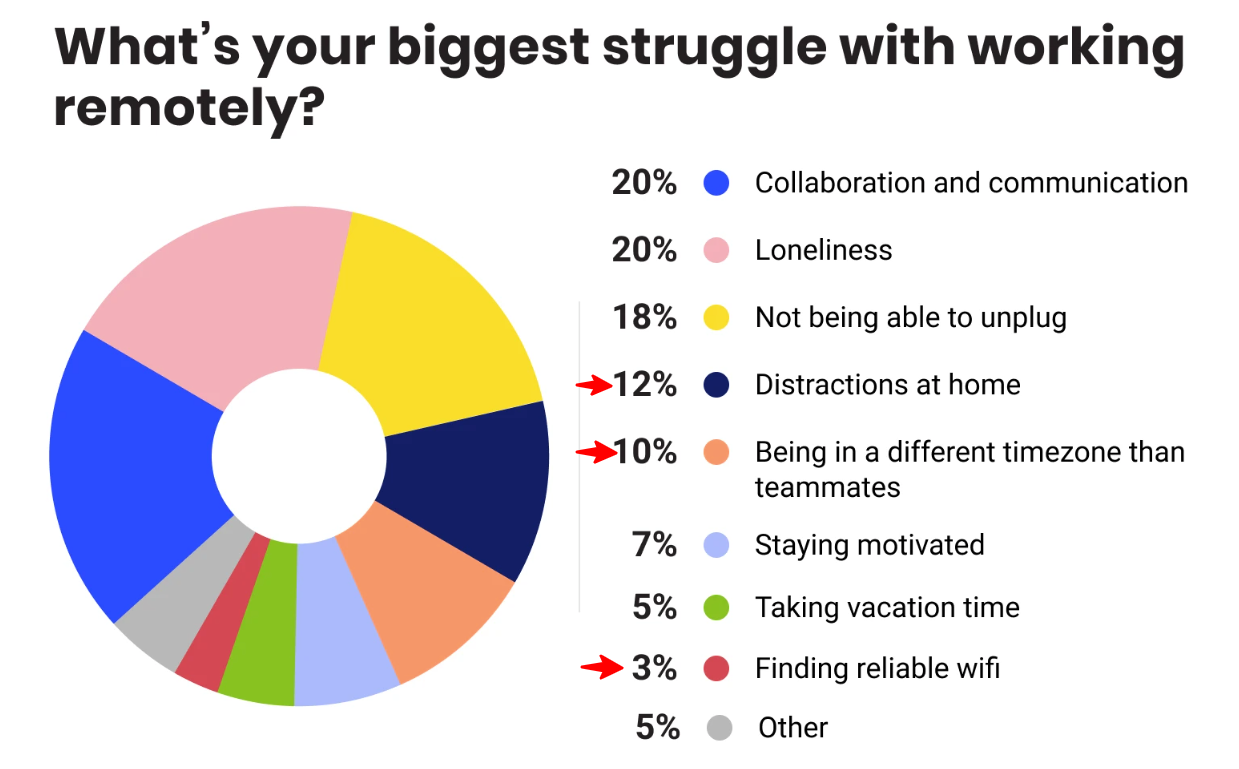 The lack of a shared office space creates futile ground for a number of logistical challenges (Image source).
The lack of a shared office space creates futile ground for a number of logistical challenges (Image source).
Compared to the previously discussed challenges, logistical issues are relatively easier to overcome since they have practical and concrete solutions. Be that as it may, without immediate and sufficient actions, these logistical challenges can impede productivity, employee engagement, and overall business performance.
Remote workers may find it challenging to understand their place in a hierarchy and understand their unique tasks in a virtual workplace. Over time, numerous persons working on the same activities concurrently may result in redundancies. This repeated work and absence of well-defined roles and responsibilities will eventually impact productivity and morale. Worse, business priorities may be overlooked amid the confusion of figuring out which worker should do what.
One of the perks of working remotely is the relative flexibility and freedom among employees to choose their own work schedule – unless a business has a clear policy on schedule adherence.
It’s a boon, yes, but for managers, it could also be a bane.
As work and life bled together, sticking to a work schedule becomes more Herculean for employees. The path to accomplishing tasks is riddled with video games, pets, kids, errands, on-demand movies and TV series, and wiki rabbit holes.
Sooner or later, managers will find their team either underworking or overworking.
Meetings can also put a wrench in employees’ schedules. Six out of 10 employees who are new to remote working are in more meetings and 40% are working more compared to when they are working on site.
 Employees are now in more meetings as a byproduct of their transitioning to remote work (Image source).
Employees are now in more meetings as a byproduct of their transitioning to remote work (Image source).
So, while the more mature remote organizations such as Buffer have mastered the art of remote work scheduling and are now moving to a four-day work week as the next step in the evolution of what they call “human-centered workplaces,” some telecommuting neophytes are struggling to maintain a consistent schedule.
While leading a remote team can be fraught with challenges, there are well-documented and proven strategies that managers can implement to help their teams transition, adapt, and get the most out of remote work.
Working at home – or from anywhere for that matter – blurs the line that demarcates where work begins and where it ends.
To help employees keep a healthy balance between their professional and personal lives, remote team managers need to facilitate the establishment of clear and reasonable boundaries for their teams.
This includes:
Cultural obstacles come as no surprise in managing multicultural remote teams. Over the recent years, more companies have strengthened their Diversity, Equity, and Inclusion (DEI) programs. And as a work arrangement that’s predisposed to acquiring talents from all corners of the world, remote team managers should prioritize diversity and inclusion to ensure a harmonious working relationship among employees.
Here are some strategies to help remote team leaders foster a culture of inclusion:
It’s easier to manage a remote team if everyone knows what’s expected of them. This keeps the entire team on the same page and eliminates any room for misunderstanding on how they are expected to work:
Here are some of the basic things that need clear and early expectation-setting:
Again, communication is the first piece of that falls and everything else goes down like a perfectly lined up pieces of dominoes. Master the art and science of remote team communication and a number of positive things will stem from it.
Below are a few tips to help managers keep free-flowing communication within their teams:
As much as remote team advocates want to deny it, sharing a physical space does have its perks, in the same way, that working remotely has its own advantages.
That said, remote team managers need to fill the “virtual gap” with something else and this is where remote team management technology comes in.
Organizations need to invest in sufficient and the right tools and software for the following key functionalities:
The key is not to fall into shiny object syndrome – managers don’t need the most expensive, latest, and fanciest options in the market. The best software is the one that meets a team’s needs given current budgets and resources.
To go remote or not to go remote – that is no longer a question. Sure, more organizations are slowly going back to the office and trying to establish a pre-pandemic sense of normalcy. However, as telecommuting becomes a more permanent fixture across modern workplaces, managers need to equip themselves with the best strategies, the right approach, and the best tools to get the most out of remote work.